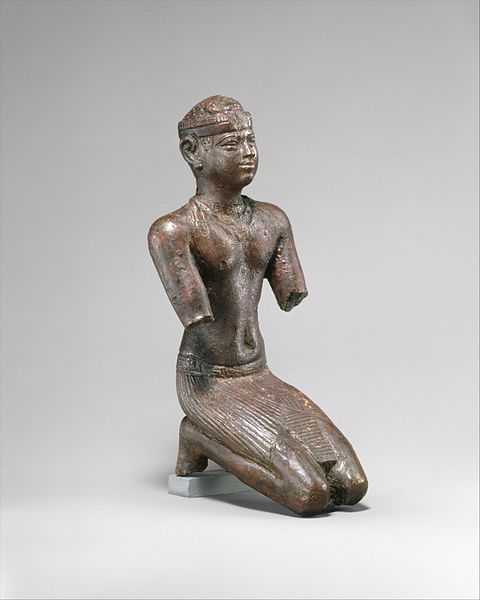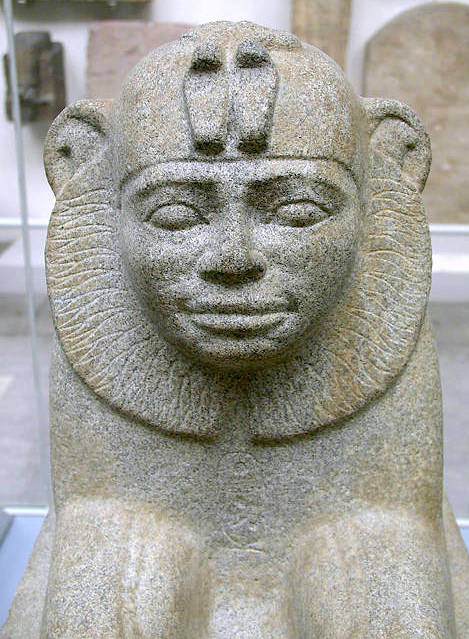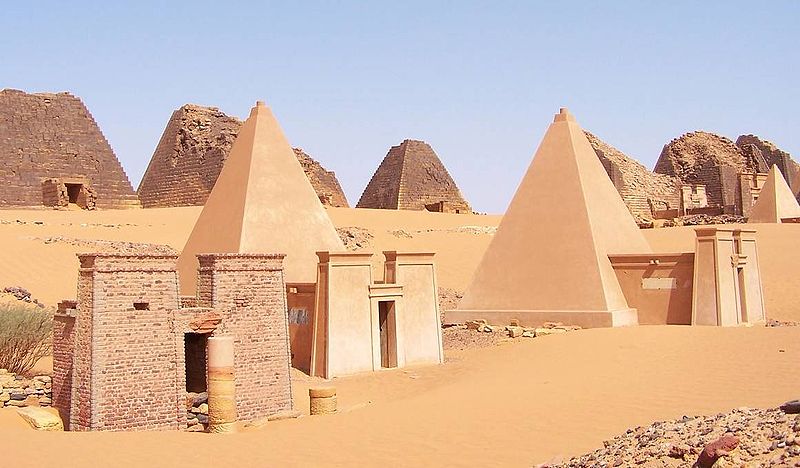Today the Houston Museum of Natural Science is hosting a fascinating lecture titled Black Pharaohs: Egypt, Nubia and Cultural Merging. The lecture will be presented by Dr. Peter Lacovara, who has been working in Egypt for over 30 years. Yesterday I had the pleasure of meeting Dr. Lacovara during a recording for the upcoming season of the Beyond Bones Podcast. This article presents some of the cool info about Egypt’s Black Pharaohs I was able to glean from him during our conversation.

Statue of an unidentified Kushite Pahraoh. You can tell he is a Kushite from his headdress with two Uraeus Serpents. Source: Wikimedia Commons.
Most people don’t associate Egypt with Africa. In history books ancient Egypt is often lumped with the Greeks and Romans into chapters about Western civilization. As for the rest of Africa, if it gets much of a mention at all, it’s usually later in the book and it usually revolves around the colonial era.
The reason ancient Egypt is often considered separate from the rest of Africa is that the Egyptians just don’t fit the popular conception about what makes a culture “African”. The thought process seems to be that since they had stone architecture, a writing system, a complex political system, and above all, they were light skinned, they were culturally distinct from other African societies.
However, in reality the Egyptians weren’t the only society in Africa to have a complex political system, writing and art. And if you think they were all light-skinned, you thought wrong. Case in point: the 25th dynasty of Egyptian rulers, also known as the Kushite dynasty. Today on Beyond Bones we’re going to talk about who these kings were and how they can show us a new perspective on Ancient Egyptian history.

Granite sphinx of Taharqa, 25th Dynasty from a temple at Kawa. Now residing in the British Museum, London. Source: Wikimedia Commons.
Who were the Kushites?
The Kingdom of Kush lay to the South of Egypt, in present day Sudan. Ancient Egyptian and Kushite civilizations developed alongside each other. The earliest references to the Kingdom of Kush are found on Egyptian monuments that date to the Early Dynastic period in Egypt, around 3100 BC.
The Egyptians had different names for the Kush. One was Ta-Sety (the Land of the Bow). Kushite archers were renowned for their skill and many joined the ranks of the Egyptian army. Another name the Egyptians had for their neighbor to the South was Ta-Neshy (the Land of the Black People). Interestingly the Greeks and Romans called the area Aethiopia (Land of the Burnt-Faced Persons) and the Arab tribes of North Africa called it Bilad al-Sudan (Land of the Blacks). Not the most sensitive way to refer to a group of people, but it illustrates the point that the majority of the Kushite population was dark skinned, not how most people would imagine an Egyptian pharaoh to look like. But in 800 AD the Kushite king Kashta conquered Egypt and in the process unknowingly refuted modern misconceptions about what it means to be African and Egyptian.

How did they come to power?
Interestingly, Kashta conquered Egypt without spilling a drop of blood. He simply took advantage of the political climate in Egypt at the time. You see, by the time Kashta ascended to the throne of Kush, the Egyptian Empire was split between a series of elites who ruled parts of Northern Egypt, and the Priests of Amun, who ruled southern Egypt. The split had occurred as a result of centuries of power play between the pharaohs and the Priests of Amun. During the New Kingdom (circa 1550 – 1069 BC, the era that preceded Kushite rule) Amun was considered the most important god in Egypt, so of course his temples and priests received a lot of offerings and gained a lot of influence. The result was something like what happened with the Catholic Church in Europe during the Middle Ages. The Cult of Amun became a powerful political influence and even competed with the authority of the pharaohs. Eventually they became the dominant political force in Southern Egypt.
After Egypt broke apart, Kashta took advantage of the situation. Egypt and Kush shared many cultural traits, including the worship of Amun. So Kashta was familiar with Amun’s Cult, and he knew how to manipulate their power structure. He had connections to the cult through his own priests of Amun in his country. One of the most important figures in the cult was the God’s Wife of Amun. The woman who held that position had tons of power. So he had his daughter, Amenirdis I proclaimed God’s Wife of Amun. Then, with his foot in the door in Egypt, he gradually extended his political influence until he was eventually proclaimed king.
Out of all the times Egypt was conquered (and there were several times) this was one of the most peaceful conquests. Of course, I guess you could expect that from a kingdom whose been your neighbor since you were both nascent civilizations.

Situla Bearing the names of Kashta and Amenirdis. Source: Wikimedia Commons.
What was their impact on Egyptian civilization?
For Egypt, the 25th dynasty was a period of revitalization. For the past couple hundred years the empire had been politically fragmented and economically unstable, but under Kushite rule, the empire was prosperous. On top of that, the Kushites, despite being foreigners, actually did a lot to promote and preserve Egyptian heritage. The Kushites had picked up a lot of Egyptian culture in previous centuries thanks to trade ties with the Land of the Pharaohs. They worshiped Egyptian gods, wore Egyptian clothes, and even wrote using a writing system based on Egyptian hieroglyphs. After they conquered Egypt, they became even bigger Egyptophiles. Kashta had a pyramid-topped tomb constructed for his burial and his successors followed suit. There are actually more pyramids in the Sudan than there are in Egypt, all of them were built during of after the Kushite domination of Egypt.
After Kashta died around 747 BC his son, Piye, consolidated Kushite rule over lower Egypt (Lower Egypt is down river, in the North of the Country) where a few Egyptian elites were putting up resistance to Kushite rule. Kashta may have declared himself king of all Egypt, but it was Piye who made that statement valid. However, even Piye was a lightweight conqueror. After defeating his enemies, he allowed them to contunue to rule as they had done before, they just had to pledge loyalty to him first.
The height of Kushite rule in Egypt was reached during the reign of Piye’s son, Taharqa, who came to the throne around 690 BC. Taharqa initiated extensive building projects throughout the Nile Valley, including an addition to the famous Temple of Amun at Thebes (modern day Luxor).
What happened to them?
The Kushite kings lost control of Egypt in 666 BC to the Assyrians. Interestingly, Taharqa incurred the wrath of the Assyrians after assisting king Hezekia of Judah in fighting off the the vast Middle Eastern empire. As a result, Jerusalem was saved from being conquered. By helping Hezekia, Taharqa was hoping to reestablish Egyptian Influence in the Middle East, unfortunately he would lose all but his home Kingdom by the end of his reign.
The 25th dynasty of Egypt serves as a perfect counterpoint to popular conceptions about what it means to be Egyptian. Ancient Egypt had as many ties to its African neighbors to the south as it did to western civilizations. In fact, the Kingdom of Kush had far more ancient ties to Egypt than any other nation. For that reason, their rule was a period of revitalization, both economically and culturally, for Egypt.
This isn’t the only case where black African culture broke the stereotype Western society has placed on them. There was also the Mali Empire, ruled over by the great Mansa Musa during the 14th century. He is believed by historians to be the richest person in the history of the World.
And there are many other stories of great African societies that we just don’t have room to discuss in this blog. Maybe we should make a series about Amazing African societies.
If you’re interested in learning more about subjects like this, check out our lectures! Tonight Dr. Peter Lacovara will be talking about Egypt’s Black Pharaohs, so if you have time you can hear more on this subject from him. If you can’t make it, that’s okay. We have lectures throughout the year covering other fascinating topics. You can find more info on them here.







